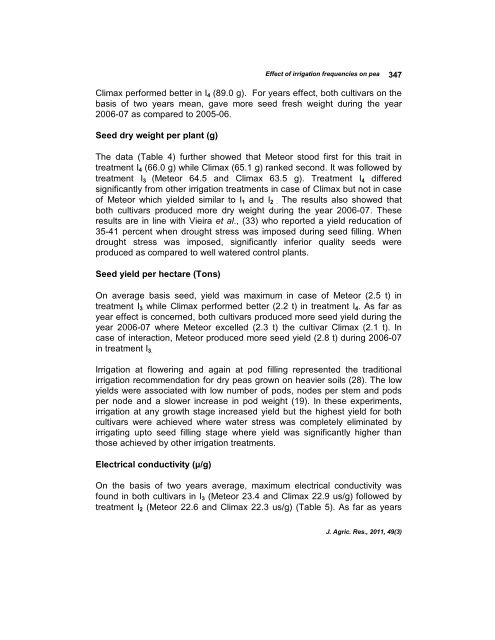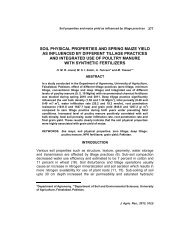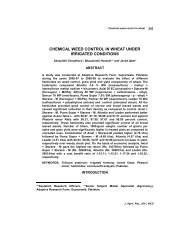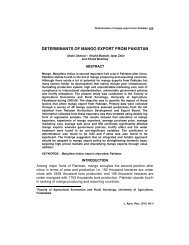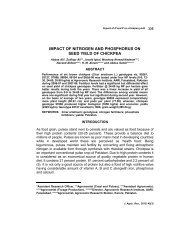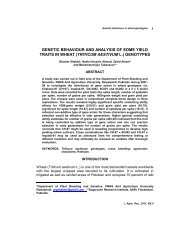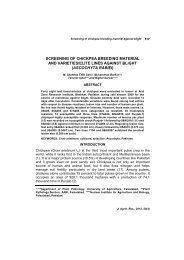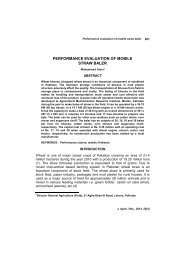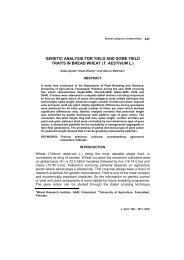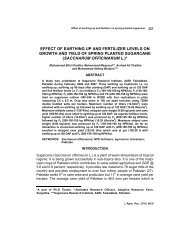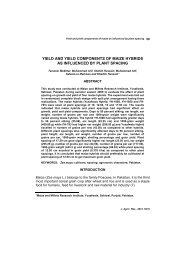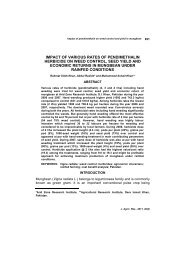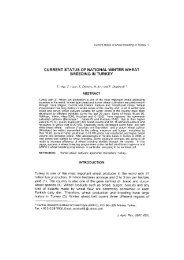Effect of varying Irrigation Frequencies on Growth, Yield and Quality ...
Effect of varying Irrigation Frequencies on Growth, Yield and Quality ...
Effect of varying Irrigation Frequencies on Growth, Yield and Quality ...
- No tags were found...
Create successful ePaper yourself
Turn your PDF publications into a flip-book with our unique Google optimized e-Paper software.
<str<strong>on</strong>g>Effect</str<strong>on</strong>g> <str<strong>on</strong>g>of</str<strong>on</strong>g> irrigati<strong>on</strong> frequencies <strong>on</strong> pea<br />
347<br />
Climax performed better in I 4 (89.0 g). For years effect, both cultivars <strong>on</strong> the<br />
basis <str<strong>on</strong>g>of</str<strong>on</strong>g> two years mean, gave more seed fresh weight during the year<br />
2006-07 as compared to 2005-06.<br />
Seed dry weight per plant (g)<br />
The data (Table 4) further showed that Meteor stood first for this trait in<br />
treatment I 4 (66.0 g) while Climax (65.1 g) ranked sec<strong>on</strong>d. It was followed by<br />
treatment I 3 (Meteor 64.5 <strong>and</strong> Climax 63.5 g). Treatment I 4 differed<br />
significantly from other irrigati<strong>on</strong> treatments in case <str<strong>on</strong>g>of</str<strong>on</strong>g> Climax but not in case<br />
<str<strong>on</strong>g>of</str<strong>on</strong>g> Meteor which yielded similar to I 1 <strong>and</strong> I 2 . The results also showed that<br />
both cultivars produced more dry weight during the year 2006-07. These<br />
results are in line with Vieira et al., (33) who reported a yield reducati<strong>on</strong> <str<strong>on</strong>g>of</str<strong>on</strong>g><br />
35-41 percent when drought stress was imposed during seed filling. When<br />
drought stress was imposed, significantly inferior quality seeds were<br />
produced as compared to well watered c<strong>on</strong>trol plants.<br />
Seed yield per hectare (T<strong>on</strong>s)<br />
On average basis seed, yield was maximum in case <str<strong>on</strong>g>of</str<strong>on</strong>g> Meteor (2.5 t) in<br />
treatment I 3 while Climax performed better (2.2 t) in treatment I 4 . As far as<br />
year effect is c<strong>on</strong>cerned, both cultivars produced more seed yield during the<br />
year 2006-07 where Meteor excelled (2.3 t) the cultivar Climax (2.1 t). In<br />
case <str<strong>on</strong>g>of</str<strong>on</strong>g> interacti<strong>on</strong>, Meteor produced more seed yield (2.8 t) during 2006-07<br />
in treatment I 3.<br />
<str<strong>on</strong>g>Irrigati<strong>on</strong></str<strong>on</strong>g> at flowering <strong>and</strong> again at pod filling represented the traditi<strong>on</strong>al<br />
irrigati<strong>on</strong> recommendati<strong>on</strong> for dry peas grown <strong>on</strong> heavier soils (28). The low<br />
yields were associated with low number <str<strong>on</strong>g>of</str<strong>on</strong>g> pods, nodes per stem <strong>and</strong> pods<br />
per node <strong>and</strong> a slower increase in pod weight (19). In these experiments,<br />
irrigati<strong>on</strong> at any growth stage increased yield but the highest yield for both<br />
cultivars were achieved where water stress was completely eliminated by<br />
irrigating upto seed filling stage where yield was significantly higher than<br />
those achieved by other irrigati<strong>on</strong> treatments.<br />
Electrical c<strong>on</strong>ductivity (µ/g)<br />
On the basis <str<strong>on</strong>g>of</str<strong>on</strong>g> two years average, maximum electrical c<strong>on</strong>ductivity was<br />
found in both cultivars in I 3 (Meteor 23.4 <strong>and</strong> Climax 22.9 us/g) followed by<br />
treatment I 2 (Meteor 22.6 <strong>and</strong> Climax 22.3 us/g) (Table 5). As far as years<br />
J. Agric. Res., 2011, 49(3)


